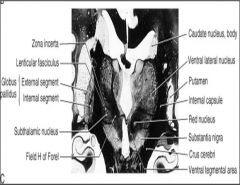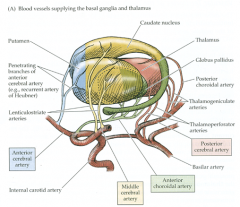![]()
![]()
![]()
Use LEFT and RIGHT arrow keys to navigate between flashcards;
Use UP and DOWN arrow keys to flip the card;
H to show hint;
A reads text to speech;
44 Cards in this Set
- Front
- Back
|
Where are the basal ganglia located?
|
located w/i white matter if cerebral hemispheres
|
|
|
Obj.
the components of the basal nuclei & associated nuclei |
Basal nuclei:
caudate nucleus putamen nucleus accumbens ventral striatum globus pallidus ventral pallidum Associated nuclei: subthalamic nucleus nigral complex pedunculopontine tegmental nucleus |
|
|
What does the term basal ganglia refer to?
|
telencephalic gray matter, collection of subcortical nuclei, made up of 2 complexes;
-striatal complex: caudate & putamen (dorsal) nucleus accumbens & ventral striatum (ventral) -pallidal complex: globus pallidus (dorsal) ventral pallidum (ventral) |
|
|
What does the term Dorsal striatal complex (neostriatum) refer to?
Ventral striatal complex? |

Caudate & putamen
nucleus accumbens (NA), ventral striatum, & olfactory tubercle, islands of calleja |
|
|
What does the term dorsal pallidum refer to?
ventral pallidum? |
Globus pallidus
Ventral extension of globus pallidus below anterior commissure |
|
|
What does the term lenticular nuclei refer to?
|
Putamen and globus pallidus
|
|
|
What is the caudate?
|
An elongated C-shaped nucleus that is composed of head, body, and tail.
-Head: bulges into lateral aspect of frontal horn of lateral ventricle -Body/tail: continue posteriorly, then inferiorly, then anteriorly maintaining a lateral relationship to body and temporal horn of lateral ventricle -Tail of the caudate ends at the amygdala |
|
|
What is the putamen?
|
Largest and most lateral part of the striatum, lying between external capsule and external segment of globus pallidus.
-Microscopicallly, caudate and putamen are identical -Rostrally, putamen is continuous with head of caudate |
|
|
What is the globus pallidus?
|
Composed of external(lateral) and internal (medial) segments that are separated by thin internal medullary lamina.
-Many bundles of myelinated fibers give it a paler appearance |
|

The nigral complex is made up of the substantia nigra & ventral tegmental area.
What is the substantia nigra? |
Largest nuclear mass in midbrain. Located anteriorly and extends length of midbrain into caudal diencephalon.
-2 parts: pars compacta (dorsal, cell-rich that contain melanin pigment (from dopamine oxidation) giving SN its black appearance) and pars reticulata (ventral, similar to internal segment of globus pallidus). |
|
|
Obj.
the vessels that supply the basal nuclei |

*ALL from internal carotid
medial striate artery (blue, from anterior cerebral, A2) lenticulostriate artery (yellow, from middle cerebral, M1) anterior choroidal (green) |
|
|
Which artery supplies the following?
Globus Pallidus Body of caudate nucleus Most of putamen Most of anterior capsule |
Lenticulostriate Arteries
|
|
|
Which artery supplies the following?
Ventral Striatal complex (Nucleus accumbens, etc) Head of caudate nucleus anterior limb of internal capsule |
Medial striate artery
|
|
|
Which artery supplies the following?
Tail of caudate nucleus Ventral posterior limb of internal capsule |
Anterior choroidal artery
|
|
|
Obj.
Major Inputs to basal nuclei |
*arrive via STRATIUM (putamen, caudate, ventral accumbens)
main input from- cerebral cortex (some from substantia nigra (compacta) & VTA |
|
|
Obj.
Major outputs to basal nuclei |
*leave via PALLIDUM (globus pallidus internal, substantia nigra (reticulata), & ventral pallidum)
main output to- thalamus (then goes to cortex) (some to PPTN & superior colliculus via substantia nigra) |
|
|
4 main functions of basal ganglia
|
general motor control (planning & execution)
eye movements (oculomotor) cognitive functions (prefrontal) emotions functions (limbic) |
|
|
Obj.
the function of four parallel channels through the basal nuclei |
1. motor- cortical & brainstem (PPTN) control of body movements & posture
2. oculomotor- cortical & brainstem control of eye movements 3. prefrontal- cognitive control of behavior (memory, etc) 4. reward system, control of biological drives (sex, food) |
|
|
Obj,
the direct and indirect pathway between striatum and outputs and, their influence on movement |
direct: stratium--> Globus Pallidus Internal (GPi)--> Substantia Nigra Pars Reticularis (SNpr)--> Ventral Pallidum--> Thalamus-->Briainstem
indirect: stratium-->Globus Pallidus external (GPe)*--> Subthalmus*--> SNpr--> Ventral Pallidum--> Thalamus--> Brainstem |
|
|
Obj.
main tracts that carry information in basal nuclei |
Internal capsule- Corticofugal & Thalamocortical
Thalamic fasiculus- Lenticular fasiculus & Ansa Lenticularis Subthalamic fasciculus- Pallidosubthalamic & Subthalmopallidal |
|
|
Differentiate btwn the 2 parts of the thalamic fasciculus (lenticular & ansa)
|
*both carry afferents from the GPi to the thalamus*
= Pallidothalamic Lenticular fasciculus- fibers from medial GPi, travel dorsally THROUGH the internal capsule Ansa Lenticularis- fibers from lateral GPi, travel ventrally UNDER the internal capsule |
|
|
Obj.
main neurotransmitters of basal nuclei & associated nuclei |
Stratum:
main inhibitory: GABA direct- Substance P* indirect- Enkephalin* excitatory interneuron: ACh* Pallidum: Main inhibitory: GABA Associated: subthalamic- excitatory- glutamate SNpc & VTA- excitatory/inhibitory- dopamine* SNpr- inhibitory- GABA PPTN- inhibitory-ACh* Cortex/Thalamus- excitatory- Glutamate |
|
|
Glutamate is always an activator, while GABA is always an inhibitor, which 2 NTs can be both?
|
Dopamine & Acetylcholine
(substance P & enkephalin are modulators) |
|
|
What is disinhibition?
|
Inhibition of an inhibitor, leading to activation
|
|
|
NTs that are in the Direct pathway ultimately lead to.......
|
Increase in cortex (thalamus) activity
= facilitation of movement & suppression of postural reflexes (via disinhibition) *ACTIVATES PPTN & superior colliculus |
|
|
NTs that are in the Indirect pathway ultimately lead to..........
|
Decrease cortex (thalamus) actvity
= inhibits movement *INHIBITS PPTN & superior colliculus |
|
|
Acetylcholine & dopamine play a cooperative role in what?
|
habit learning (relative to movement behaviors)
Note: basal nuclei do NOT directly initiate movement |
|
|
Obj.
the role of acetylcholine on basal nuclei function |
excitatory in BOTH pathways
(when dopamine is high favors direct, when low favor indirect) |
|
|
Obj.
the role of dopamine on basal nuclei function |
activates direct pathway (via D1)
inhibits the indirect pathway (via D2) = facilitates movement |
|
|
Obj.
how dysfunction of basal nuclei lead to hypokinetic or hyperkinetic disorders |
hyperkinetic:
overactivity of direct pathway underactivity of indirect pathway hypokinetic: underactivity of direct pathway overactivity of indirect pathway |
|
|
What are hyperkinetic disorders characterized by?
hypokinetic? |
Too much movement, decreased postural reflexes
(Huntington's, Hemiballismus) Difficult slow movement, increased postural reflexes= rigidity (Parkinsons) |
|
|
What does parkinsonism symptoms and signs results from?
|
loss of dopamine from deterioration of substantia nigra pars compacts (VTA)
|
|
|
Parkinson's disease
symptoms |
-lewdy bodies (cytoplasmic inclusions)
-loss of dopaminergic neurons in substantia nigra -major motor symptoms: tremor at rest cogwheel rigidity bradykinesia/akinesia (loss of movement) postural instability -non-motor symptoms: dementia procedural memory loss executive dysfuction (attention etc) mood, sleep, sensory, autonomic disturbances |
|
|
Describe the mechanism of Parkinson's disease
|
loss of dopamine (DA)-->
DA activation via D1 is lost-->direct pathway becomes underactive= reduced activity of spinal motor neurons/less movement (akinesia) DA inhibition via D2 is lost-->indirect pathway becomes more overactive= increased inhibition of PPTN neurons/ disinhibition of postural spinal reflexes (rigidity) |
|
|
What causes Parkinson's tremors?
What makes them better/ worse? |
overactive subthalamus
better(dampens)= DA worse= Ach |
|
|
What is the mesocortical (prefrontal circuit) affect of loss of dopamine?
|
memory loss, dementia, reduced executive funtion
|
|
|
What is the mesolimbic (limbic circuit) affect of loss of dopamine?
|
mood disorders
|
|
|
Parkinson's treatments:
|
1. Increase dopamine (L-dopa, agonist, MAOI)
2. Decrease ACh (reduce activity of indirect pathway) 3. Surgical lesion of GP or VL thalamus 4. Deep brain (electrical) stimulation of GP, VL, STN |
|
|
What is Huntington Disease (Chorea) caused by?
|
genetic mutation (htt) w/ 100% penetrance
(autosomal dominant)--> glutamate excitotoxicity leads to loss of caudate & putamen cholinergic neurons--> loss of Ach interneurons |
|
|
Obj.
Huntington's disease Symptoms & treatments |
symptoms:
early stage- absentminded, irritable, depressed, clumsy, falls late stage- bedridden, dementia, loss of speech & cognition--> death treatments: none |
|
|
Describe the mechanism of Huntington's disease
|
loss of GABA, ENK, & Ach-->
underactivity of indirect pathway (GABA/ENK)--> excessive & involuntary movement (chorea) & decreased postural reflexes--> eventual underactivity of direct pathway (GABA/SP)--> akinesia & rigidity |
|
|
Disruption of the prefrontal & limbic channels from Huntingtons leads to what affects?
|
prefrontal- loss of cognition & memory, dementia
limbic- irritability, depression |
|
|
What is hemiballismus?
|
movement disorder
-Most often seen with lesion of the contralateral subthalamic nucleus -decreased GPi & SNpr (indirect) activity--> increased thalamic-cortex & PPTN activity |
|
|
Hemiballismus
symptoms & treatments |
symptoms:
Sudden, involuntary, often violent, flinging movement of one or both extremities of one side. treatments: dopamine blockers (reduce direct pathway) lesions or stimulation of globus pallidus |

